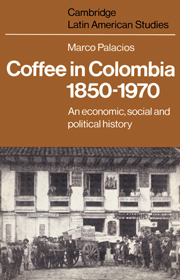Book contents
- Frontmatter
- Contents
- List of tables
- List of figures
- List of maps
- Preface
- Acknowledgements
- 1 The Colombian export economy in the second half of the nineteenth century
- 2 The making of an oligarchy
- 3 Land and society in central Colombia in the second half of the nineteenth century
- 4 The internal structure of the coffee haciendas, 1870–1930
- 5 Living conditions and internal contradictions in the hacienda structure
- 6 Inflation, devaluation, and export taxes, 1870–1904
- 7 Crisis and transition towards the second cycle of expansion, 1903–10
- 8 Private appropriation of public lands in the west
- 9 Sociopolitical elements in antioquen̄o colonization
- 10 Coffee expansion and the strengthening of the Liberal model of development, 1910–50
- 11 The international cycle and coffee policies confronting the peasant, 1930–70
- Appendix 1 Sample of coffee estates in Cundinamarca and Antioquia, 1870–98
- Appendix 2 Piece-rate wages on two coffee haciendas, 1879–1933
- Appendix 3 Concentration of the coffee export trade (percentage controlled by 20 leading companies), 1933–70
- Appendix 4 Foreign exchange rates in Colombia, 1870–1970
- Weights and measures
- Glossary
- Notes
- Biblography
- Index
- CAMBRIDGE LATIN AMERICAN STUDIES
11 - The international cycle and coffee policies confronting the peasant, 1930–70
Published online by Cambridge University Press: 06 October 2009
- Frontmatter
- Contents
- List of tables
- List of figures
- List of maps
- Preface
- Acknowledgements
- 1 The Colombian export economy in the second half of the nineteenth century
- 2 The making of an oligarchy
- 3 Land and society in central Colombia in the second half of the nineteenth century
- 4 The internal structure of the coffee haciendas, 1870–1930
- 5 Living conditions and internal contradictions in the hacienda structure
- 6 Inflation, devaluation, and export taxes, 1870–1904
- 7 Crisis and transition towards the second cycle of expansion, 1903–10
- 8 Private appropriation of public lands in the west
- 9 Sociopolitical elements in antioquen̄o colonization
- 10 Coffee expansion and the strengthening of the Liberal model of development, 1910–50
- 11 The international cycle and coffee policies confronting the peasant, 1930–70
- Appendix 1 Sample of coffee estates in Cundinamarca and Antioquia, 1870–98
- Appendix 2 Piece-rate wages on two coffee haciendas, 1879–1933
- Appendix 3 Concentration of the coffee export trade (percentage controlled by 20 leading companies), 1933–70
- Appendix 4 Foreign exchange rates in Colombia, 1870–1970
- Weights and measures
- Glossary
- Notes
- Biblography
- Index
- CAMBRIDGE LATIN AMERICAN STUDIES
Summary
General characteristics of coffee production, 1930–70.
Since its beginnings, coffee cultivation has developed with other kinds of cultivation and with cattle. Of the 4.5 million hectares contained in Colombia's coffee zones in 1970, a little less than one-fourth were planted with coffee, which clearly reflects land usage within the productive units of the coffee belt: while the mean farm size was 15.05 hectares, the mean coffee-grove size on each finca was barely 3.53 hectares. These figures show the inherent limitations in a treatment such as the one I undertake in this final chapter: to treat coffee cultivation separately from its immediate agricultural environment. To understand the changes in the organization of the production of coffee in Colombia during the twentieth century, one must of course also analyse the relationship between these changes and the tendencies and events of the world coffee market, together with the role which is assigned to coffee in the liberal model of development.
My intention is first to outline the more general trends which have become apparent in the productive sector. I shall consider then to what extent such tendencies may have been responses to changes in the structure of the international coffee market.
For the student of Colombian coffee history, 1932 stands out as the year which marks the shift from the ‘pre-statistical’ to the ‘statistical’ period, with the publication in that year of the Coffee Census. Naturally there was no sharp break between the two periods, rather a gradual process dating back to the nineteenth century and arising out of the various attempts to organize agricultural statistics on a more scientific basis.
- Type
- Chapter
- Information
- Coffee in Colombia, 1850–1970An Economic, Social and Political History, pp. 227 - 258Publisher: Cambridge University PressPrint publication year: 1980



